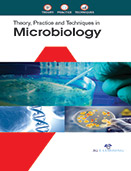Agriculture and Life Sciences

Microbes play an important role in our everyday lives. Because of the presence of microbes in all walks of human life, there is a constant interaction of the microbes on human life. The vast majority of the bacteria in the body are rendered harmless by the protective effects of the immune system, and a few are beneficial. In fact, the relationship between microbes and humans is delicate and complex. The microbes that normally live in association with humans on the various surfaces of the body, such as Lactobacillus and Bifidobacterium, are known to protect their hosts from infections and otherwise promote nutrition and health. Microbiology deals with the study of microscopic organisms, such as bacteria, viruses, archaea, fungi and protozoa.
This book “Theory, Practice and Techniques in Microbiology” offers an exhaustive treatment of techniques in the multidisciplinary field of applied microbiology, and a detailed survey of recent and important advances. This discipline includes biochemistry, physiology, cell biology, ecology, evolution and clinical aspects of microorganisms, including the host response to these agents. It focuses on the interaction of microorganisms and the host cell, presenting detailed experimental techniques for modern microbiological research. As agents of infectious disease they cause untold human misery, yet their beneficial activities are diverse, ranging from the natural cycling of chemical elements through to the production of food, beverages and pharmaceuticals. This introductory text provides a clear and accessible account of the interactions between microbes, their environment and other organisms, using examples of both beneficial and adverse activities. Biologists use knowledge of how bacteria, viruses and protists affect cells to find cures and treatments for various ailments. Without microbiology, scientists wouldn’t have the ability to see the inner structure of a cell and learn how bacteria, viruses and protists develop, grow and infect other cells. This book will be of interest for all students and professionals actively involved in natural and environmental sciences and engineering, and for those working in industry, authorities, and consulting companies.